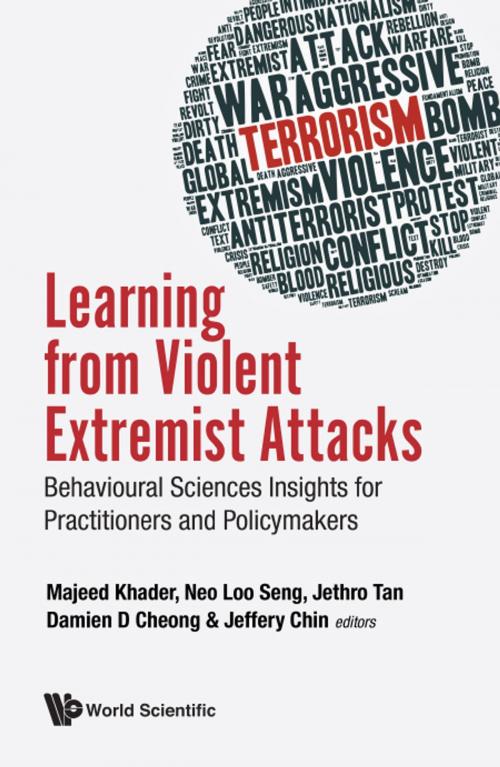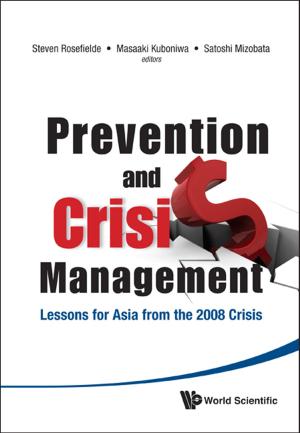Learning from Violent Extremist Attacks
Behavioural Sciences Insights for Practitioners and Policymakers
Nonfiction, Social & Cultural Studies, Political Science, Politics, Law Enforcement, Health & Well Being, Psychology| Author: | Majeed Khader, Loo Seng Neo, Jethro Tan;Damien D Cheong;Jeffery Chin | ISBN: | 9789813275454 |
| Publisher: | World Scientific Publishing Company | Publication: | December 19, 2018 |
| Imprint: | WSPC | Language: | English |
| Author: | Majeed Khader, Loo Seng Neo, Jethro Tan;Damien D Cheong;Jeffery Chin |
| ISBN: | 9789813275454 |
| Publisher: | World Scientific Publishing Company |
| Publication: | December 19, 2018 |
| Imprint: | WSPC |
| Language: | English |
How can we use psychology and the behavioural sciences to aid law enforcement to better identify violent extremists? What can we learn from past attacks to ensure that our society is more prepared? How can societies deal with tension after these attacks?
Violent extremists are evolving, constantly honing their strategies to out-manuever the 'good guys'. Faced with the quandary, challenges, and responsibilities of ensuring the safety of the society, practitioners and policymakers have to take decisive steps to respond and mitigate the impact of an attack. However, the daunting task of countering violent extremism is still plagued by the lack of basic understanding of the phenomenon.
This book, Learning from Violent Extremist Attacks: Behavioural Sciences Insights for Practitioners and Policymakers, attempts to fill a gap in the extant literature by offering a behavioural sciences approach to integrate our understanding of the threat of violent extremism, with knowledge drawn from diverse fields, such as psychology, sociology, history, political science, technology, and communications to identify the lessons learned and provide scientifically defensible interventions and approaches for both the practitioners and policymakers.
Contents:
-
Learning to Deal with Violent Extremists:
-
Insights from Regional Violent Extremism Developments:
-
Terrorist Attacks in Indonesia: Insights for Practitioners and Policymakers (Bilveer Singh)
Confronting the Threat on an ISIS Province in Mindanao (Joseph Franco)
Insights for Practitioners and Policymakers from the Marawi Siege, May–October 2017 (Jasminder Singh)
-
Insights for the Identification of Violent Extremists:
-
Threat Assessment of Violent Extremism: Considerations and Applications (Whistine Chai)
Leveraging Smart Technology for Better Counter-Terrorism Intelligence (Muhammad Faizal Bin Abdul Rahman)
A Common Framework for Pre-Radicalisation Indicators (Omer Ali Saifudeen)
Five Things to Know About Assessment Tools for Violent Extremism (Vaishnavi Honnavalli)
Lone Wolf Violent Extremism and Mental Illness: Learning Lessons from an Asian Perspective (Shi Hui Tee)
-
Insights for Community Level Interventions:
-
The 4M Strategy of Combating Violent Extremism: An Analysis (Kumar Ramakrishna)
Bystander Intervention to Prevent Radicalisation (Loo Seng Neo, Joyce S Pang, and Jeffery Chin)
The Inseparable Brothers-in-Arms: Understanding the Instrumentality of Violent Extremism in Strengthening Intergroup Conflict (Dashalini Katna)
Engaging Youth in Counter-Violent Extremism (CVE) Initiatives (Thomas Koruth Samuel)
-
Insights for Dealing with At-Risk Population:
-
At-Risk and Radicalised Singaporean Youths: Themes Observed and Considerations for a Youth-Centric Rehabilitation Framework (Bridget Robert)
Understanding Intergroup Contact on Terrorist Prisoners in Indonesia (Mirra Noor Milla and Ahmad Naufalul Umam)
In the Search of Home: Tackling Support for ISIS Ideology Among Ordinary People (Whinda Yustisia and Wahyu Cahyono)
-
-
Learning to Respond to Violent Extremist Attacks:
-
Strategies to Build Resilience:
-
Preparing for the Day After Terror: Five Things to Do to Build National Resilience (Jethro Tan, Jane Quek, and Gabriel Ong)
Psychological First Aid: Addressing Worldwide Challenges for Implementation in an Asian Context (Shuktika Bose)
Responding to a Violent Extremist Attack: Insights from the 2016 Orlando Shooting Incident (Shi Hui Tee)
Against the Norm: The Act of Helping During Violent Extremist Attacks (Pamela Goh)
-
Strategies to Build Cyber Psychological Resilience:
-
Managing Social Media in the Event of a Terror Attack (Stephanie Neubronner)
Media Effects within the Context of Violent Extremism in the Post-9/11 Era (Leevia Dillon, Joshua D Freilich, and Steven M Chermak)
Social Media Response After an Attack: Perspectives from the Jakarta Bombings (Jony Eko Yulianto and Jessie Janny Thenarianto)
Fake News After a Terror Attack: Psychological Vulnerabilities Exploited by Fake News Creators (Ken Chen Xingyu)
-
Strategies to Build Emergency Preparedness:
-
Emergency Preparedness Towards Terror Attacks in Singapore (Siew Maan Diong, Wei Jie Tan, and Raymond Lee)
The Looming, the Creeping, and the Black Swan: Modern Crises and Recommendations for Building Resilience (Sheryl Chua Hwee Chin, Majeed Khader, and Eunice Tan)
Striking the Right Balance in Relation to Target Hardening (Damien D Cheong)
Risk and Crisis Management During a Major Terror Attack: Singapore's Approach (Damien D Cheong)
-
Strategies to Build Communal Harmony:
-
The Effects of Religious Fundamentalism on Communal Harmony (Verity Er)
How Can Right-Wing Extremism Exacerbate Islamophobia After a Jihadi Attack? Insights from Europe (Nur Aisyah Abdul Rahman)
Islamophobia and Its Aftermath: Strategies to Manage Islamophobia (Nur Elissa Ruzzi'eanne Bte Rafi'ee)
-
Readership: Students and professionals interested in issues of radicalisation, terrorism and extremism, counter-terrorism, counter-extremism, counter-radicalisation, terrorist rehabilitation, and behavioural sciences.
Key Features:
- Backed by the study of psychological and behavioural sciences, this book provides the framework to learn and make sense of the threat of violent extremism, which is a core concern in the region
- This book is written by practitioners and subject-matter experts in countering violent extremism (CVE) for practitioners and policymakers
- This book consolidates the latest thinking on violent extremism from an Asian perspective
- This book would be useful for: law enforcement officers; intelligence officers who are involved in the fight against violent extremism; researchers and analysts working in the field of violent extremism; policymakers from all countries keen to respond to violent extremism; general readers who are interested in violent extremism
How can we use psychology and the behavioural sciences to aid law enforcement to better identify violent extremists? What can we learn from past attacks to ensure that our society is more prepared? How can societies deal with tension after these attacks?
Violent extremists are evolving, constantly honing their strategies to out-manuever the 'good guys'. Faced with the quandary, challenges, and responsibilities of ensuring the safety of the society, practitioners and policymakers have to take decisive steps to respond and mitigate the impact of an attack. However, the daunting task of countering violent extremism is still plagued by the lack of basic understanding of the phenomenon.
This book, Learning from Violent Extremist Attacks: Behavioural Sciences Insights for Practitioners and Policymakers, attempts to fill a gap in the extant literature by offering a behavioural sciences approach to integrate our understanding of the threat of violent extremism, with knowledge drawn from diverse fields, such as psychology, sociology, history, political science, technology, and communications to identify the lessons learned and provide scientifically defensible interventions and approaches for both the practitioners and policymakers.
Contents:
-
Learning to Deal with Violent Extremists:
-
Insights from Regional Violent Extremism Developments:
-
Terrorist Attacks in Indonesia: Insights for Practitioners and Policymakers (Bilveer Singh)
Confronting the Threat on an ISIS Province in Mindanao (Joseph Franco)
Insights for Practitioners and Policymakers from the Marawi Siege, May–October 2017 (Jasminder Singh)
-
Insights for the Identification of Violent Extremists:
-
Threat Assessment of Violent Extremism: Considerations and Applications (Whistine Chai)
Leveraging Smart Technology for Better Counter-Terrorism Intelligence (Muhammad Faizal Bin Abdul Rahman)
A Common Framework for Pre-Radicalisation Indicators (Omer Ali Saifudeen)
Five Things to Know About Assessment Tools for Violent Extremism (Vaishnavi Honnavalli)
Lone Wolf Violent Extremism and Mental Illness: Learning Lessons from an Asian Perspective (Shi Hui Tee)
-
Insights for Community Level Interventions:
-
The 4M Strategy of Combating Violent Extremism: An Analysis (Kumar Ramakrishna)
Bystander Intervention to Prevent Radicalisation (Loo Seng Neo, Joyce S Pang, and Jeffery Chin)
The Inseparable Brothers-in-Arms: Understanding the Instrumentality of Violent Extremism in Strengthening Intergroup Conflict (Dashalini Katna)
Engaging Youth in Counter-Violent Extremism (CVE) Initiatives (Thomas Koruth Samuel)
-
Insights for Dealing with At-Risk Population:
-
At-Risk and Radicalised Singaporean Youths: Themes Observed and Considerations for a Youth-Centric Rehabilitation Framework (Bridget Robert)
Understanding Intergroup Contact on Terrorist Prisoners in Indonesia (Mirra Noor Milla and Ahmad Naufalul Umam)
In the Search of Home: Tackling Support for ISIS Ideology Among Ordinary People (Whinda Yustisia and Wahyu Cahyono)
-
-
Learning to Respond to Violent Extremist Attacks:
-
Strategies to Build Resilience:
-
Preparing for the Day After Terror: Five Things to Do to Build National Resilience (Jethro Tan, Jane Quek, and Gabriel Ong)
Psychological First Aid: Addressing Worldwide Challenges for Implementation in an Asian Context (Shuktika Bose)
Responding to a Violent Extremist Attack: Insights from the 2016 Orlando Shooting Incident (Shi Hui Tee)
Against the Norm: The Act of Helping During Violent Extremist Attacks (Pamela Goh)
-
Strategies to Build Cyber Psychological Resilience:
-
Managing Social Media in the Event of a Terror Attack (Stephanie Neubronner)
Media Effects within the Context of Violent Extremism in the Post-9/11 Era (Leevia Dillon, Joshua D Freilich, and Steven M Chermak)
Social Media Response After an Attack: Perspectives from the Jakarta Bombings (Jony Eko Yulianto and Jessie Janny Thenarianto)
Fake News After a Terror Attack: Psychological Vulnerabilities Exploited by Fake News Creators (Ken Chen Xingyu)
-
Strategies to Build Emergency Preparedness:
-
Emergency Preparedness Towards Terror Attacks in Singapore (Siew Maan Diong, Wei Jie Tan, and Raymond Lee)
The Looming, the Creeping, and the Black Swan: Modern Crises and Recommendations for Building Resilience (Sheryl Chua Hwee Chin, Majeed Khader, and Eunice Tan)
Striking the Right Balance in Relation to Target Hardening (Damien D Cheong)
Risk and Crisis Management During a Major Terror Attack: Singapore's Approach (Damien D Cheong)
-
Strategies to Build Communal Harmony:
-
The Effects of Religious Fundamentalism on Communal Harmony (Verity Er)
How Can Right-Wing Extremism Exacerbate Islamophobia After a Jihadi Attack? Insights from Europe (Nur Aisyah Abdul Rahman)
Islamophobia and Its Aftermath: Strategies to Manage Islamophobia (Nur Elissa Ruzzi'eanne Bte Rafi'ee)
-
Readership: Students and professionals interested in issues of radicalisation, terrorism and extremism, counter-terrorism, counter-extremism, counter-radicalisation, terrorist rehabilitation, and behavioural sciences.
Key Features:
- Backed by the study of psychological and behavioural sciences, this book provides the framework to learn and make sense of the threat of violent extremism, which is a core concern in the region
- This book is written by practitioners and subject-matter experts in countering violent extremism (CVE) for practitioners and policymakers
- This book consolidates the latest thinking on violent extremism from an Asian perspective
- This book would be useful for: law enforcement officers; intelligence officers who are involved in the fight against violent extremism; researchers and analysts working in the field of violent extremism; policymakers from all countries keen to respond to violent extremism; general readers who are interested in violent extremism















